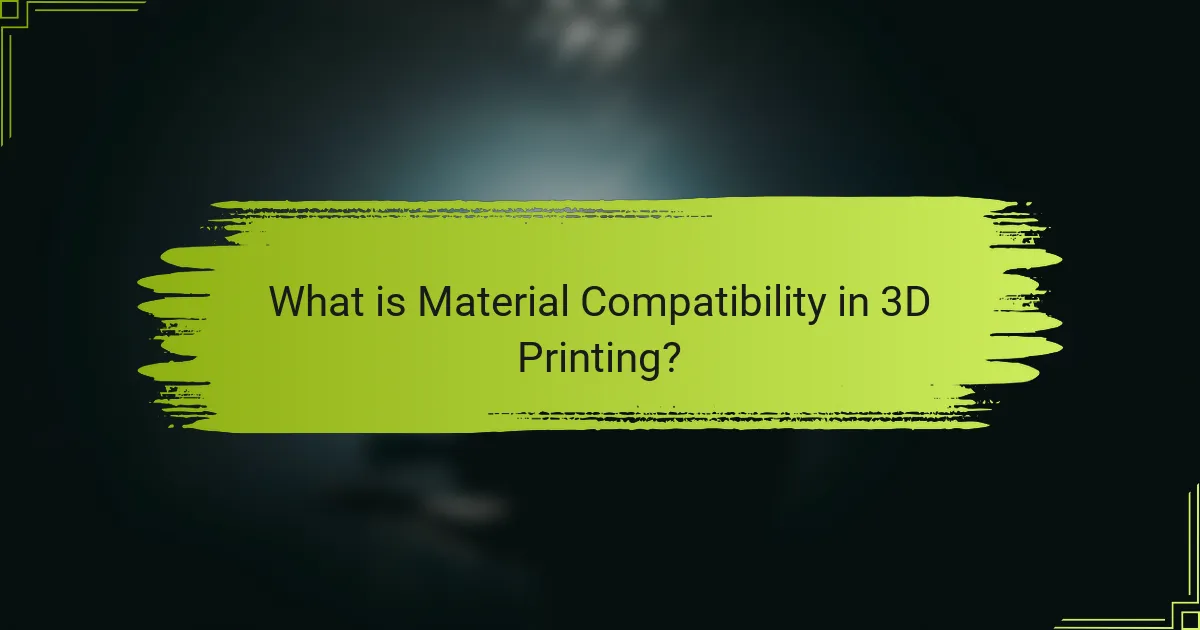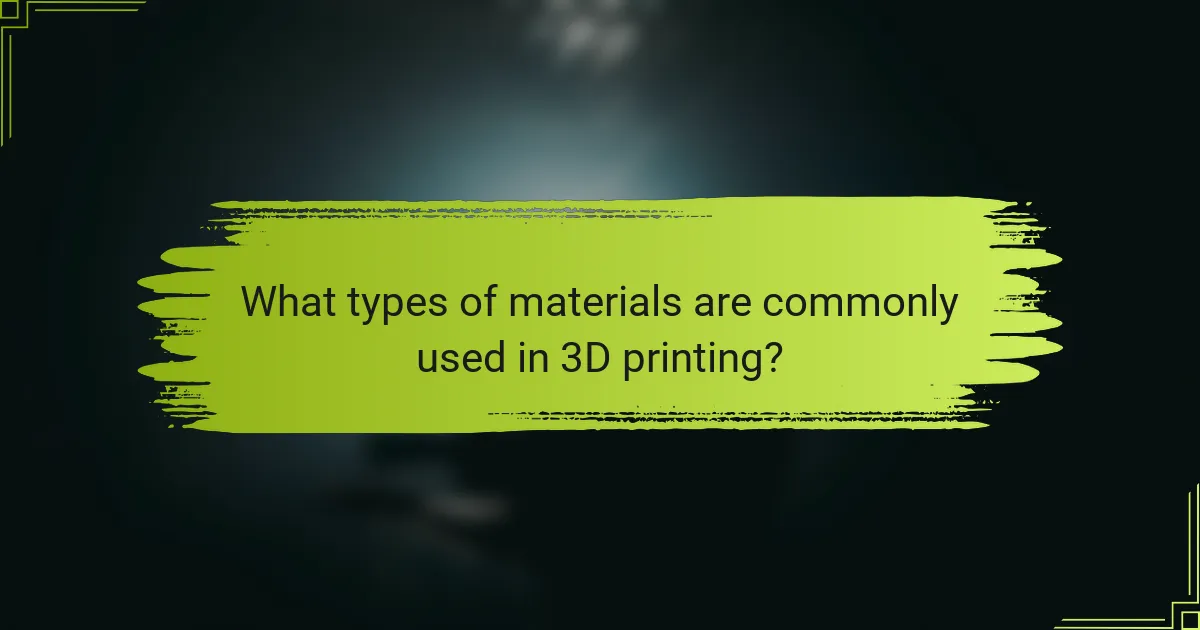
What is Material Compatibility in 3D Printing?
Material compatibility in 3D printing refers to the ability of different materials to work together without adverse effects. This concept is crucial for achieving successful prints and ensuring structural integrity. When materials are compatible, they bond well during the printing process. This leads to improved mechanical properties and durability of the final product. Conversely, incompatible materials can cause issues such as warping, delamination, or poor adhesion. Studies show that material selection significantly impacts the performance and quality of 3D printed objects. For example, using compatible thermoplastics can enhance layer adhesion and reduce failure rates.
Why is Material Compatibility Important in 3D Printing?
Material compatibility is crucial in 3D printing because it affects the quality and functionality of printed objects. Different materials have unique properties that can impact adhesion, strength, and durability. If materials are not compatible, issues such as warping, delamination, or failure can occur during printing. For instance, using incompatible materials can lead to weak layer bonding, compromising the structural integrity of the final product. Research indicates that proper material selection can enhance print quality and reduce production costs. According to a study published in the Journal of Materials Science, effective material compatibility increases the mechanical properties of 3D printed parts.
What are the potential consequences of poor material compatibility?
Poor material compatibility can lead to structural failures in 3D printed objects. This occurs when materials do not bond effectively during the printing process. Weak adhesion can cause parts to delaminate or break under stress. Additionally, poor compatibility may result in warping or deformation of the final product. In some cases, chemical reactions between incompatible materials can produce defects. These defects can compromise the functionality and durability of the printed item. Ultimately, poor material compatibility can lead to increased costs due to wasted materials and the need for reprints. Therefore, ensuring material compatibility is crucial for achieving optimal results in 3D printing.
How does material compatibility impact the final product quality?
Material compatibility significantly impacts final product quality in 3D printing. Compatible materials bond effectively during the printing process. This enhances structural integrity and durability of the final product. Incompatible materials can lead to weak points or delamination. For instance, using a filament and resin that do not adhere well can result in failures. Studies show that proper material pairing improves mechanical properties by up to 30%. Therefore, ensuring material compatibility is crucial for achieving high-quality 3D printed products.
What factors influence material compatibility in 3D printing?
Material compatibility in 3D printing is influenced by several key factors. These include the chemical properties of the materials, such as their reactivity and adhesion characteristics. Temperature compatibility is also crucial, as different materials may have varying melting points. Mechanical properties, including tensile strength and flexibility, affect how materials bond during the printing process. The layer adhesion, which determines how well layers stick together, is vital for structural integrity. Additionally, the printing method used can impact compatibility; for instance, FDM and SLA processes have different material requirements. Lastly, environmental factors, such as humidity and temperature of the printing environment, can affect material performance. Each of these factors plays a significant role in achieving successful 3D prints with compatible materials.
How do temperature and material properties affect compatibility?
Temperature and material properties significantly influence compatibility in 3D printing. High temperatures can alter the viscosity of materials, affecting their flow and adhesion. Materials with similar thermal expansion coefficients tend to bond better. Conversely, mismatched coefficients can lead to warping or delamination. Additionally, the glass transition temperature of a material determines its usability range. Materials must be within their optimal temperature range to ensure proper layer adhesion. For instance, PLA has a lower melting point than ABS, making them less compatible when printed together. Compatibility is crucial for achieving strong, durable prints.
What role does the 3D printing technology play in material compatibility?
3D printing technology significantly influences material compatibility by allowing precise control over material properties during the printing process. This technology enables the use of various materials, such as plastics, metals, and ceramics, tailored for specific applications. Each material can be engineered to achieve desired characteristics like strength, flexibility, and thermal resistance.
Moreover, 3D printing facilitates the creation of composite materials, enhancing compatibility by combining different substances. This adaptability is crucial for industries like aerospace and healthcare, where material performance is critical. Studies show that optimized material compatibility can lead to improved mechanical properties and durability in printed parts.
For instance, research published in the journal “Additive Manufacturing” highlights how material selection directly affects the performance of 3D printed components. Thus, 3D printing plays a vital role in ensuring that materials used are compatible with the intended application, leading to enhanced functionality and efficiency.

What types of materials are commonly used in 3D printing?
Commonly used materials in 3D printing include PLA, ABS, PETG, and nylon. PLA (Polylactic Acid) is a biodegradable thermoplastic, known for its ease of use and low warping. ABS (Acrylonitrile Butadiene Styrene) is popular for its strength and durability, making it suitable for functional parts. PETG (Polyethylene Terephthalate Glycol) offers a balance of strength and flexibility, resistant to impact and moisture. Nylon is known for its toughness and flexibility, often used in functional prototypes. These materials are widely adopted due to their unique properties and versatility in various printing applications.
What are the characteristics of thermoplastics in 3D printing?
Thermoplastics in 3D printing are characterized by their ability to be melted and reformed multiple times. This property allows for easy processing and recycling. They exhibit good mechanical strength and flexibility. Common thermoplastics used include PLA, ABS, and PETG. Each type has unique attributes, such as PLA’s biodegradability and ABS’s impact resistance. Thermoplastics typically have lower thermal resistance compared to thermosets. They can be printed at lower temperatures, making them compatible with a wide range of printers. Their versatility makes them popular choices for various applications in 3D printing.
How do different thermoplastics compare in terms of compatibility?
Different thermoplastics exhibit varying degrees of compatibility based on their chemical structure and properties. For instance, ABS and PLA are generally incompatible due to their differing polarities. ABS has a non-polar structure, while PLA is polar. This difference affects adhesion and fusion during 3D printing.
On the other hand, PETG and ABS show better compatibility. Both materials can bond effectively, making them suitable for multi-material prints. Nylon is another thermoplastic that has good compatibility with various materials, including TPU, due to its flexibility and adhesion properties.
Compatibility also depends on processing conditions such as temperature and pressure during printing. Higher temperatures can increase compatibility by enhancing flow and adhesion. Studies indicate that proper surface preparation can improve compatibility among different thermoplastics, leading to better mechanical properties in the final product.
In summary, the compatibility of thermoplastics varies widely. Factors such as chemical structure, processing conditions, and surface treatment play crucial roles in determining how well different thermoplastics can be used together in 3D printing applications.
What are the best practices for using thermoplastics in 3D printing?
The best practices for using thermoplastics in 3D printing include selecting the right thermoplastic for the application. Popular options include PLA, ABS, and PETG. Each thermoplastic has unique properties that influence print quality and strength. Proper temperature settings are crucial; for instance, ABS typically requires higher extrusion temperatures than PLA. Bed adhesion techniques, like using a heated bed or adhesive sprays, enhance print stability. Layer height and print speed adjustments can optimize surface finish and detail. Regular maintenance of the printer ensures consistent performance. Lastly, proper storage of thermoplastics prevents moisture absorption, which can affect print quality.
What are the benefits and drawbacks of using metals in 3D printing?
The benefits of using metals in 3D printing include high strength, durability, and heat resistance. Metals like titanium and aluminum are commonly used for aerospace and automotive applications. They offer excellent mechanical properties and can withstand extreme conditions. Additionally, metal 3D printing allows for complex geometries that are difficult to achieve with traditional manufacturing techniques.
However, drawbacks exist as well. Metal 3D printing can be expensive due to material costs and the need for specialized equipment. The printing process may also lead to residual stresses and warping, affecting part accuracy. Furthermore, post-processing is often required to achieve desired surface finishes, adding time and cost to production.
What considerations should be made when selecting metal materials?
When selecting metal materials, several key considerations must be evaluated. First, assess the mechanical properties required for the application, such as strength, ductility, and hardness. Different metals exhibit varying levels of these properties. Second, consider the corrosion resistance needed for the environment in which the material will be used. Certain metals, like stainless steel, offer superior corrosion resistance. Third, evaluate the thermal and electrical conductivity of the metal, as these factors can impact performance in specific applications. Fourth, analyze the cost and availability of the metal materials, as budget constraints can influence selection. Finally, consider the compatibility of the metal with the 3D printing process being utilized, as not all metals are suitable for every printing technique. These considerations ensure that the selected metal material meets the specific requirements of the project while optimizing performance and cost-efficiency.
How does metal compatibility vary with different 3D printing processes?
Metal compatibility varies significantly across different 3D printing processes. Each process utilizes unique techniques and materials that affect the interaction between metals. For instance, selective laser melting (SLM) allows for a wide range of metal alloys, including titanium and aluminum. This process promotes high density and strength in printed parts.
In contrast, direct metal laser sintering (DMLS) is limited to metals that can be sintered effectively. This includes stainless steel and cobalt-chrome alloys. The thermal properties of these materials influence their compatibility with DMLS.
Binder jetting, another process, can use a broader spectrum of metals but often requires post-processing for strength. This method can incorporate metals like iron and bronze, which may not be suitable for other techniques.
Furthermore, metal compatibility is also affected by the layer thickness and cooling rates specific to each process. For example, faster cooling rates in SLM can lead to different microstructures compared to slower processes like DMLS.
These variations highlight the importance of selecting the appropriate 3D printing method based on the desired metal’s properties and intended application.

How can one ensure optimal material compatibility in 3D printing?
To ensure optimal material compatibility in 3D printing, one should select materials that are chemically compatible with each other. Research indicates that understanding the thermal properties of materials is crucial. Materials with similar melting temperatures tend to bond better. Additionally, using compatible adhesion promoters can enhance layer bonding. It is also important to consider the print settings, such as temperature and speed, which can affect material interaction. Conducting compatibility tests before full-scale printing can prevent issues. Lastly, consulting material datasheets provides valuable insights into compatibility.
What testing methods can be used to evaluate material compatibility?
Common testing methods to evaluate material compatibility include tensile testing, impact testing, and thermal analysis. Tensile testing measures the strength and ductility of materials under tension. Impact testing assesses a material’s toughness and ability to absorb energy during sudden forces. Thermal analysis, such as differential scanning calorimetry (DSC), evaluates how materials respond to temperature changes. These methods help determine if materials can work together without adverse reactions. Specific results from these tests guide material selection in 3D printing applications.
How can compatibility tests be conducted effectively?
Compatibility tests can be conducted effectively by following a structured approach. First, identify the materials to be tested. Next, establish criteria for compatibility, such as mechanical properties, thermal stability, and chemical resistance. Conduct tests under controlled conditions to ensure accuracy. Utilize standardized testing methods, such as ASTM or ISO protocols, for reliable results. Document all findings meticulously to facilitate analysis. Analyze the data to determine compatibility levels. Adjust parameters as needed and repeat tests for validation. This methodical approach ensures comprehensive evaluation of material compatibility in 3D printing.
What metrics should be considered during compatibility testing?
Key metrics for compatibility testing in 3D printing include mechanical properties, thermal properties, and adhesion strength. Mechanical properties assess tensile strength, flexibility, and impact resistance. Thermal properties evaluate melting temperature, thermal expansion, and heat resistance. Adhesion strength measures the bond between materials during the printing process. These metrics ensure that materials will perform well together in a 3D printed product. Accurate assessment of these attributes leads to successful material combinations and optimal print quality.
What are the best practices for selecting compatible materials?
The best practices for selecting compatible materials include understanding the properties of each material. Compatibility often depends on thermal expansion, mechanical strength, and chemical resistance. Analyze the intended application to determine the required material characteristics. Conduct tests to evaluate adhesion and bonding between materials. Consult material datasheets for compatibility information. Consider environmental factors such as temperature and humidity. Review case studies or industry standards for guidance. Using these practices ensures optimal performance in 3D printing applications.
How can one identify the right material for specific applications?
To identify the right material for specific applications, one must assess the requirements of the project. Key factors include mechanical properties, thermal stability, and environmental resistance. For example, ABS is widely used for its toughness and heat resistance. PLA is preferred for its ease of printing and biodegradability. Compatibility with the 3D printer is also crucial. Each printer may have specific material limitations. Research shows that understanding the application’s demands leads to better material selection. The right choice enhances performance and longevity of the printed object.
What resources are available for researching material compatibility?
Resources for researching material compatibility include databases, academic journals, and industry guidelines. Online databases like MatWeb provide material properties and compatibility data. Academic journals such as the Journal of Materials Science publish peer-reviewed articles on material interactions. Industry guidelines from organizations like ASTM International offer standards for material compatibility testing. Additionally, manufacturer datasheets often detail compatibility information for specific materials. These resources collectively support informed decision-making in material selection for 3D printing applications.
What common troubleshooting tips exist for material compatibility issues?
Common troubleshooting tips for material compatibility issues include verifying material specifications and understanding their properties. Check for temperature requirements and ensure they align with the 3D printer settings. Conduct a test print to assess adhesion and layer bonding. Investigate the chemical compatibility between materials to avoid reactions. Use appropriate adhesives or bonding agents when necessary. Monitor printer settings for speed and extrusion rates to optimize results. Lastly, consult manufacturer guidelines for recommended material pairings. These steps help mitigate compatibility challenges effectively.
The main entity of the article is material compatibility in 3D printing. The article explores the importance of material compatibility for achieving high-quality prints, highlighting how compatible materials enhance structural integrity and durability while preventing issues such as warping and delamination. It discusses factors influencing compatibility, including chemical properties, temperature, and printing methods, as well as the characteristics of commonly used materials like thermoplastics and metals. Additionally, best practices for selecting materials, conducting compatibility tests, and troubleshooting issues are provided to optimize 3D printing outcomes.